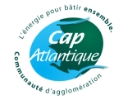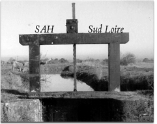Biology / Ecology
The Nantes white-throated Bluethroat (Luscinia svecica namnetum) is an endemic subspecies of the French Atlantic coast that belongs to the Muscicapidae family. It has the size of a robin (13-14 cm). The male has an azure plastron punctuated with a small white spot, finely edged in black and then with a large red stripe. The less vividly colored female has a whitish throat and breast.
Migratory species, it winters mainly in Portugal and up to North Africa. It arrives in the salt marshes in mid-March and breeds from April to June. It installs its nest in a depression on the ground, sheltered from a scrub. For nesting, this species prefers the slopes separating two salt bassins, especially if they are colonized by thick woody soda (Sueda vera) or blackthorn (Prunus spinosa) bushes. Probably due to the rarety of this type of vegetation, the species has recently adapted to other wetlands such as reed beds, sedge habitats or wet meadows with bushy vegetation. It also frequents these environments after reproduction or during migration.
It feeds on invertebrates (insects, molluscs, spiders, small crustaceans), most of which are taken from moist soil, especially bare vases.
Protection and conservation status
Protected species in France, listed in Annex I of the Birds Directive.
It is classified as “Low consideration” on the red list of nesting birds in France and Pays-de-la-Loire.
Distribution and status of populations on Natura 2000 sites
In France, this subspecies occurs from the Arcachon basin to Mont St-Michel where it comes into contact with another subspecies Luscinia svecica cyanecula.
In Europe, the species is considered to be stable or increasing slightly. The French population of Black-throated Gorgebleue of Nantes would represent only 5,500 to 9,500 pairs (2013, Roché et al.). The Brière marshes now constitute the French stronghold of this subspecies with 3,500 to 4,400 males (Marquet et al, 2014).
In the area covered by the LIFE Sallina project, the workforce is as follows:
– Between 100 and 300 breeding pairs on the Natura 2000 site Marais breton and Ile de Noirmoutier (2017)
– About 800 breeding pairs identified in 2012 in the Guérande and Mès salt basins. A follow-up planned for 2020 will make it possible to clarify this information.
Conservation objectives / threats / actions planned in LIFE
This subspecies is threatened in salt marshes by the intensification of maintenance practices for slope vegetation.
Actions favorable to the conservation of the species are:
– Ensure traditional salt exploitation (maintenance of scrubs areas during works, calendar of mechanical interventions, etc.).
– Maintain bushy vegetation with woody soda for nesting.
– Maintain a mosaic of exploited and non-exploited plots on the scale of the salt marshes.
– Maintain song posts (scattered willows) within the reed beds, avoiding their development.
The actions planned in LIFE are to maintain a traditional salt exploitation as well as a mosaic of habitats will therefore be favorable to this species.
Specific follow-ups are planned to refine the size of the population of the Loire region.













